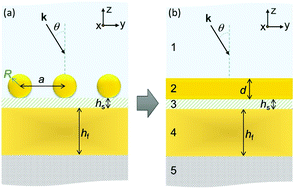Unravelling the optical responses of nanoplasmonic mirror-on-mirror metamaterials
Abstract
Mirror-on-mirror platforms based on arrays of metallic nanoparticles, arranged top-down or self-assembled on a thin metallic film, have interesting optical properties. Interaction of localized surface-plasmons in nanoparticles with propagating surface-plasmons in the film underpins the exotic features of such platforms. Here, we present a comprehensive theoretical framework which emulates such a system using a five-layer-stack model and calculate its reflectance, transmittance, and absorbance spectra. The theory rests on dipolar quasi-static approximations incorporating image-forces and effective medium theory. Systematically tested against full-wave simulations, this simple approach proves to be adequate within its obvious applicability limits. It is used to study optical signals as a function of nanoparticle dimensions, interparticle separation, metal film thickness, the gap between the film and nanoparticles, and incident light characteristics. Several peculiar features are found, e.g., quenching of reflectivity in certain frequency domains or shift of the reflectivity spectra. Schemes are proposed to tailor those as functions of the mentioned parameters. Calculating the system's optical responses in seconds, as compared to much longer running simulations, this theory helps to momentarily unravel the role of each system parameter in light reflection, transmission, and absorption, facilitating thereby the design and optimisation of novel mirror-on-mirror systems.


 Please wait while we load your content...
Please wait while we load your content...